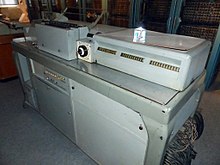Dehomag
Dehomag was a German subsidiary of IBM with monopoly in the German market before and during World War II.[1] The word was an acronym for Deutsche Hollerith-Maschinen Gesellschaft mbH (Template:Lang-en). Hollerith refers to the German-American inventor of the technology of punched cards, Herman Hollerith. In April 1949 the company name was changed to IBM Deutschland.[2]
Background

The technology of punched cards dates back to the 18th century when it was used for mass production of woven textiles and later used as a recording and playback system in player pianos. The use of punched cards for recording and tabulating data was first proposed and used by Semen Korsakov around 1805. In 1832 Charles Babbage proposed using similar cards to program and to store computations for his calculating engine. Punched card technology was further developed for data-processing by Herman Hollerith from the 1880s. It was used for the 1890 United States Census and for the census work of several foreign governments.[3]
History
Willy Heidinger, an acquaintance of Hollerith, licensed all of Hollerith’s The Tabulating Machine Company patents in 1910, and created Dehomag in Germany.[4] In 1911 The Tabulating Machine Company was amalgamated (via stock acquisition) with three others, creating a fifth company, the Computing-Tabulating-Recording Company (CTR).[5][6] In 1923 CTR acquired 90% ownership of Dehomag, thus acquiring patents developed by them.[7] In 1924 CTR was renamed IBM.[8]
Holocaust

As an IBM subsidiary, Dehomag became the main provider of computing expertise and equipment in Nazi Germany.[6] Dehomag gave the German government the means for two official censuses of the population after 1933 and for searching its data.[9] It gave the Nazis a way of tracing Jews and dissidents using the powerful automated search tools using the IBM machines. It enabled them to search databases rapidly and efficiently, and the methods were used throughout occupied Europe by the Gestapo and others to locate and arrest its victims, so contributing to the Holocaust.[10][11]
Dehomag leased and maintained the German government's punched card machines.[6] Dehomag general manager for Germany, Hermann Rottke, reported to IBM President Thomas J. Watson in New York.[10][11] It was legal for IBM to conduct business with Germany directly until the United States entered the war in December 1941.[12]
IBM New York established a special subsidiary in the occupied General Government territory, Watson Business Machines, to deal with railway traffic there during the Holocaust in Poland.[10][11] The German Transport Ministry used IBM machines under the New York-controlled subsidiary in Warsaw, not the German subsidiary. Watson Business Machines operated a punch card printing shop near the Warsaw Ghetto. The punch cards bore the indicia of the German subsidiary Dehomag.[10][11][13]
Leon Krzemieniecki, the last surviving person involved in the administration of the rail transportation to Auschwitz and Treblinka, stated he knew the punched card machines were not German machines, because the labels were in English. Income from the machines leased in General Government was sent through Geneva to IBM in New York.[10][11][12]
See also
References
- ^ Black, Edwin (March 26, 2002). "Final Solutions". Village Voice. Retrieved October 23, 2017.
- ^ Black, Edwin (2002). IBM and the Holocaust: The Strategic Alliance between Nazi Germany and America's Most Powerful Corporation. Washington, DC: Time Warner Paperbacks. p. 541. ISBN 0751531995.
- ^ Black, Edwin (2012). IBM and the Holocaust: The Strategic Alliance between Nazi Germany and America's Most Powerful Corporation. Expanded Edition (2. ed.). Washington, DC: Dialog Press. p. 25. ISBN 978-0914153276.
- ^ Black, Edwin (2012). IBM and the Holocaust: The Strategic Alliance between Nazi Germany and America's Most Powerful Corporation. Expanded Edition (2. ed.). Washington, DC: Dialog Press. p. 30. ISBN 978-0914153276.
- ^ Black, Edwin (2012). IBM and the Holocaust: The Strategic Alliance between Nazi Germany and America's Most Powerful Corporation. Expanded Edition (2. ed.). Washington, DC: Dialog Press. p. 31. ISBN 978-0914153276.
- ^ a b c Elkin, Larry M. (July 6, 2011). "IBM: A Centenarian's Imperfect But Impressive Recall". Tech Insider. Business Insider. Retrieved October 1, 2017.
- ^ Aspray (ed.), William (1990). Computing Before Computers. Iowa State University Press. p. 137. ISBN 0-8138-0047-1.
{{cite book}}:|last=has generic name (help) - ^ Black, Edwin (2012). IBM and the Holocaust: The Strategic Alliance between Nazi Germany and America's Most Powerful Corporation. Expanded Edition (2. ed.). Washington, DC: Dialog Press. p. 44. ISBN 978-0914153276.
- ^ Black, Edwin (2001). IBM and the Holocaust : the strategic alliance between Nazi Germany and America's most powerful corporation (1. ed.). New York: Crown Publishers. ISBN 0609607995.
- ^ a b c d e Black, Edwin (2012). IBM and the Holocaust: The Strategic Alliance between Nazi Germany and America's Most Powerful Corporation. Expanded Edition (2. ed.). Washington, DC: Dialog Press. ISBN 978-0914153276.
- ^ a b c d e Burkeman, Oliver (March 29, 2002). "IBM 'dealt directly with Holocaust organisers'". The Guardian. guardian.co.uk. Retrieved August 24, 2017.
- ^ a b Black, Edwin (May 19, 2002). "The business of making the trains to Auschwitz run on time". Editorial. SFGate. San Francisco Chronicle. Retrieved October 1, 2017.
- ^ Black, Edwin (2012). "IBM's Role in the Holocaust — What the New Documents Reveal". Huffington Post. Retrieved October 23, 2017.
Further reading
- Black, Edwin (2012). IBM and the Holocaust: The Strategic Alliance between Nazi Germany and America's Most Powerful Corporation. Expanded Edition. ISBN 978-0914153276
- Anita Ramasastry. A Swiss court allows Gypsies' Holocaust lawsuit to proceed. CNN, 2004-07-08.
- Dehomag D11 tabulation machine exhibit in the United States Holocaust Memorial Museum at the Wayback Machine (archived October 26, 2004)
